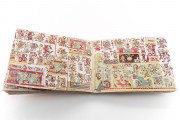The Codex Zouche-Nuttall—also known as the Codex Tonindeye—is a fifteenth-century manuscript that originated in Mixteca (Mexico). Despite its nickname, it is not a book composed of sheets folded and sewn at the spine but rather is an accordion-folded screenfold. Brilliantly colored pictographs, glyphs, and toponyms narrate the dynastic histories of the city-states of Tilantongo, Teozacoalco, and probably Zaachila on the obverse and the biography of Lord Eight Deer (1063-1115 CE) on the reverse. It is the most visually striking of the Mixtec codices.
Like many other Mesoamerican books, the support is deerskin covered with a thin layer of plaster. Most of its forty-seven panels are painted on both sides. Page size averages 19 × 23.5 cm. When unfolded, it is longer than eleven meters. It is the "sister manuscript" of the Codex Yuta Tnoho.
Two Painter-Scribes, One Style
One painter-scribe was responsible for the forty-three painted pages on the reverse, which was painted first. A different painter-scribe, perhaps aided by assistants, added the content to the forty-one painted pages of the obverse, painted thereafter. Both employed the traditional technique of arraying figures and objects defined by black outlines and mostly filled with color on the unpainted plaster ground. The palette on both sides is dominated by red and yellow ocher, but the paintings of the obverse display a wider palette that includes two shades of bright blue. Both painter-scribes used vertical red lines to articulate the nearly relentless up-and-down boustrophedon order of reading of the contents.
The "Jaguar Claw"
The subject of the manuscript reverse is the partial biography of Eight Deer "Jaguar Claw," the singular most important ruler of all Mixtec history. In this, it shares considerable content with the Codex Colombino-Becker. The story reads from right to left, meandering up and down over the pages. Although incomplete, the biography includes the events surrounding the murder of Eight Deer's half-brother in a sweat bath.
Rulers from Heaven
The obverse of the manuscript, also to be read from right to left and up and down, presents histories that emphasize the supernatural origins of the ruling dynasties. It opens with a representation of the emergence of Lord Eight Wind from the earth. Several pages (pp. 15-19, 21, 22) are devoted to describing rituals involving making offering, the bringing of fire, and the placing of cult bundles—all in the service of establishing dynastic rule.
A Gift to the British Museum
The exact path the Codex Zouche-Nuttall traveled from Mexico to England is unknown. It found a home in the collection of Robert Curzon, fourteenth Baron Zouche (1810-1873). It was placed in the care of the British Museum after his death and eventually bequeathed to the museum by his sister. It was in the collection of the Museum of Mankind (a branch of the British Museum) during its existence (1970-1997).
We have 1 facsimile edition of the manuscript "Codex Zouche-Nuttall": Codex Zouche-Nuttall facsimile edition, published by Akademische Druck- u. Verlagsanstalt (ADEVA), 1987
Request Info / Price





























